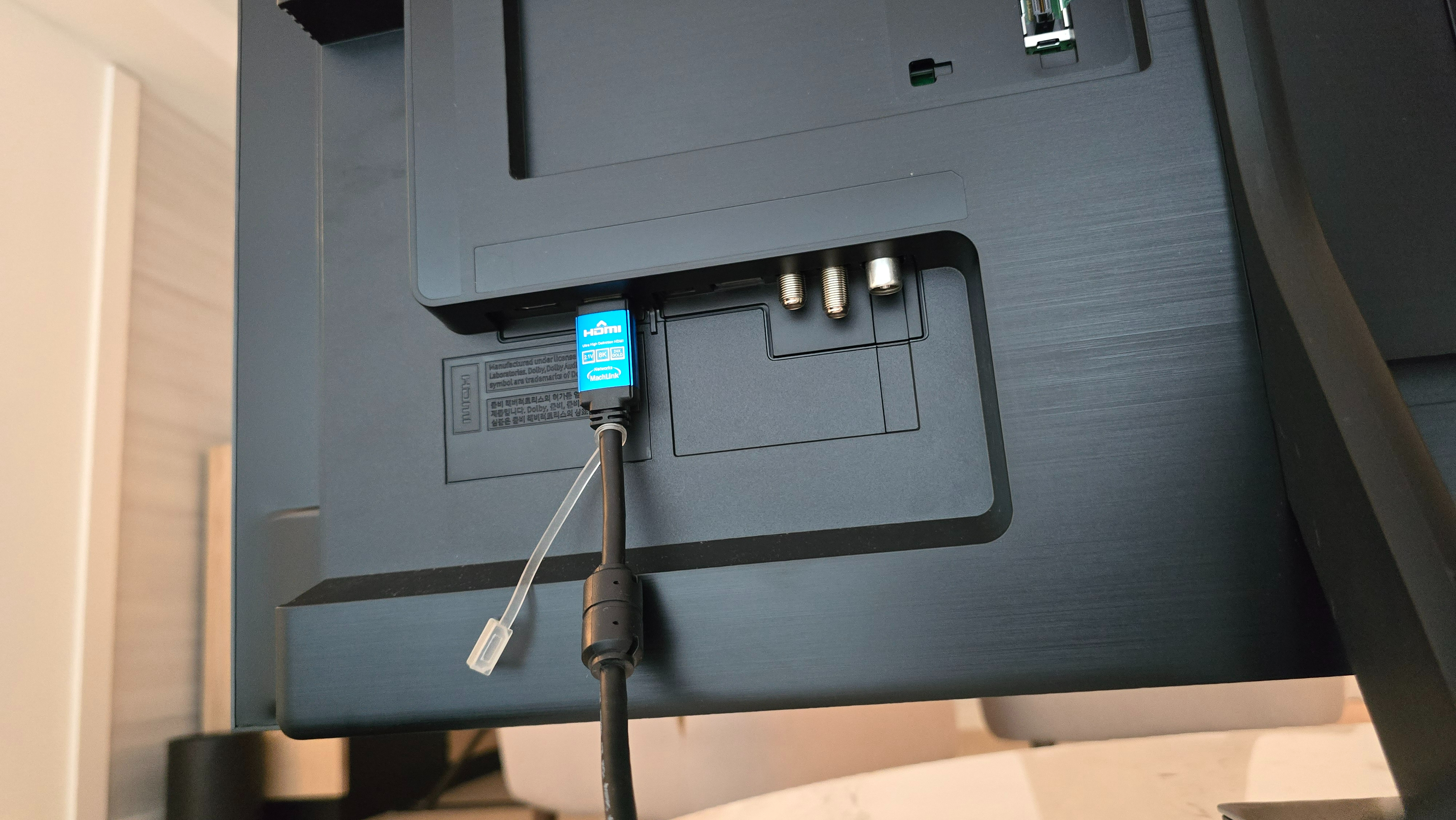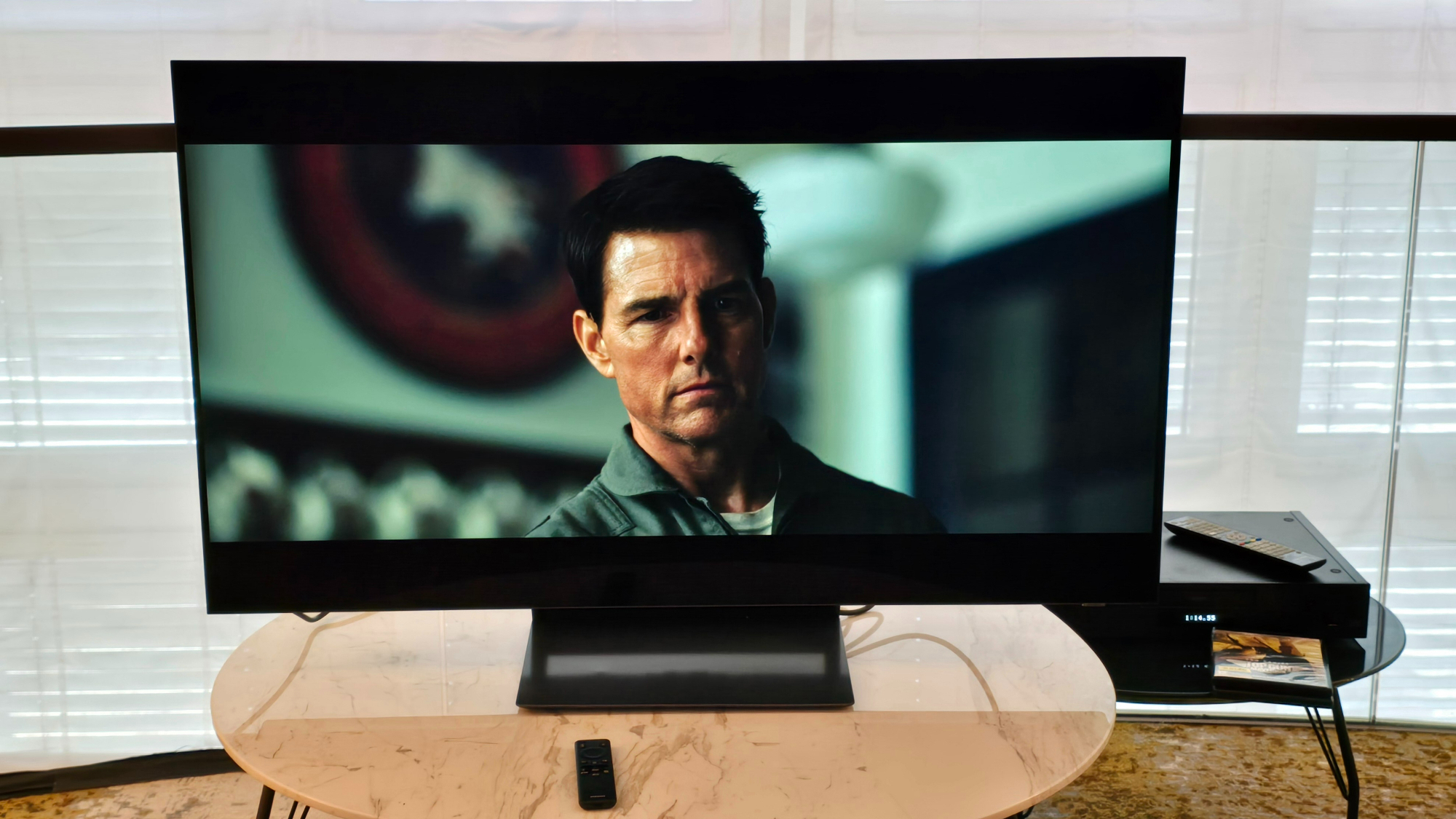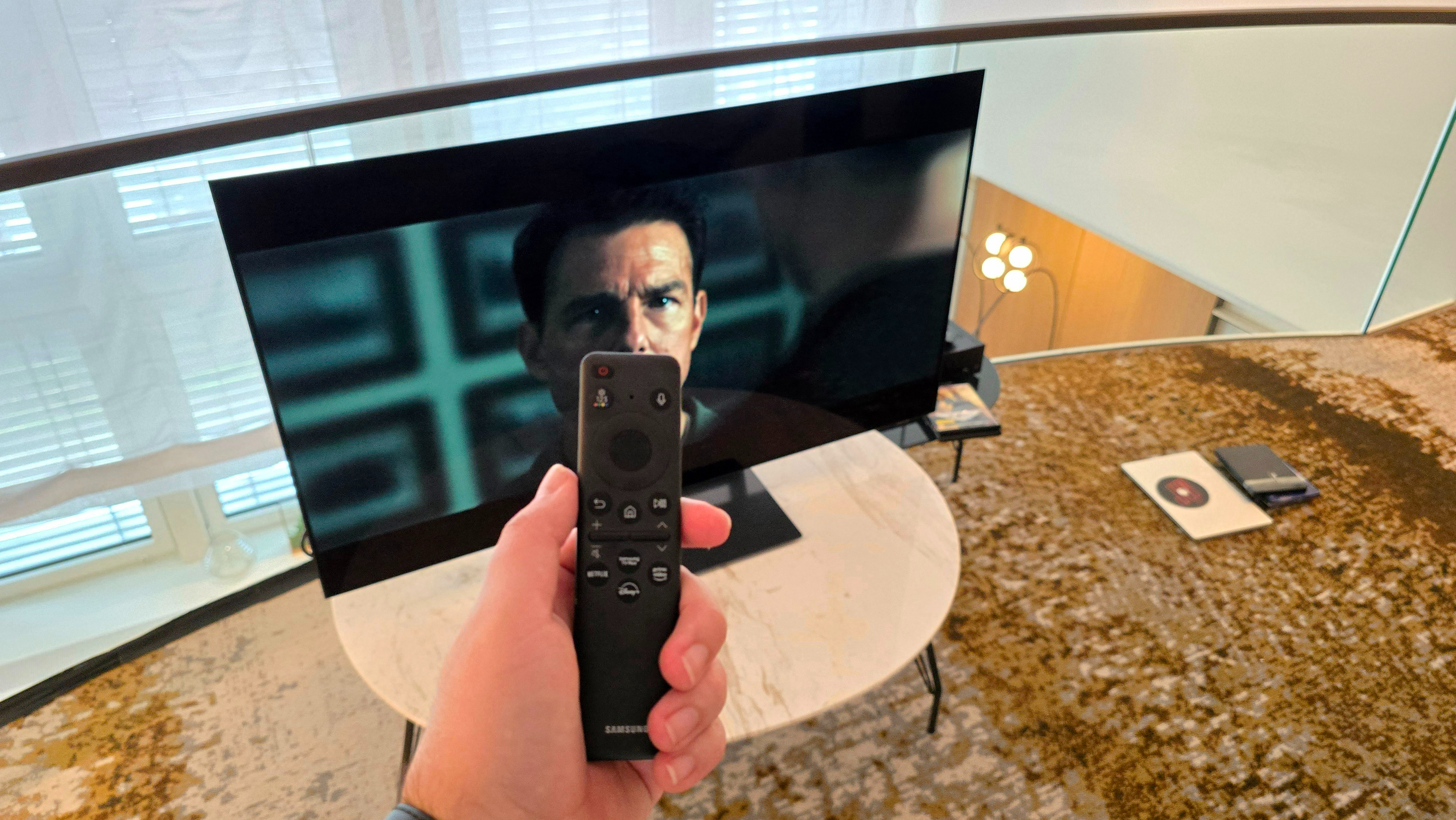Early Verdict
It's too early to decide on a final verdict on the S90D, but this compact OLED TV provides solid contrast, balanced colours and sharp details in our first look.
Pros
- +
Impressive contrast
- +
Appears more balanced than other Samsung TVs
- +
More versatile screen size options
Cons
- -
Lots of competition from other small OLEDs
- -
Middling built-in sound system
- -
Slightly awkward protruding stand
Why you can trust What Hi-Fi?
In February of this year, Samsung kindly flew me out to Frankfurt for its "World of Samsung" experience, at which I got an early insight into its latest AV products. While its flagship S95D QD-OLED TV was front and centre on the show floor, I was privy to a behind-closed-doors demonstration of the new S90D OLED TV.
As part of this, I managed to sit down with the new 48-inch model for a good hour's worth of hands-on testing time with a selection of 4K Blu-ray discs, which is a rarity at events like this – and something I certainly appreciated.
Admittedly, testing conditions weren't perfect, but this is a hands-on review compiling my initial thoughts after all; you'll have to wait for the full fat What Hi-Fi? review for a final verdict. So does Samsung's smallest OLED to date make a good first impression? I certainly think so, even if the absence of Quantum Dots is felt.
Price
While we don't have full international pricing for the S90D yet, Samsung has commenced pre-orders for this TV in the US, which has given us our first look at the S90D's price. The 55- and 65-inch S90D TVs cost $1999 and $2699 respectively in the States, which roughly equates to around £1600 / AU$3100 or £2150 / AU$4150 at the time of writing using currency conversion; however that sounds a tad cheap to us.
The S90C, Samsung's 2023 step-down QD-OLED model was priced as follows at launch, which might offer a more accurate insight into how much the S90D will cost when it launches later this year:
- 55 inch: £1999 / $1899 / AU$3299
- 65 inch: £2799 / $3299, AU$4299
- 77 inch: £3899 / $3599 / AU$6799
That's rather reassuring if you ask us, as the 55-inch model is the exact same price, while the 65-inch model is actually $100 cheaper. That doesn't tell the full story, however, as we're still awaiting pricing for the new 42- and 48-inch models, and the 83-inch model that was added to the lineup late last year.
Design

It might not surprise you to hear that the 48-inch S90D looks like a shrunken down S90C. Samsung is reusing its 2023 designs with its 2024 TVs, albeit with a few minor tweaks. This was evident with the S95D, which I also saw at the show, which bore a striking resemblance to the S95C.
Samsung has made some minor adjustments to the stand, namely covering a gap that was found on the S90C which makes the TV look a bit more premium; although whether you like the stand will be down to your personal taste. Personally, I find that it protrudes a bit too far, which will likely make soundbar placement awkward, but I do appreciate the centralised pedestal design as it ensures it'll fit on a range of media units (or more importantly, test benches).
Elsewhere the S90D is a svelte and suave unit, with super slim bezels around the display and a razor-thin side profile that bulges out towards the bottom to accommodate the internal components and ports; this TV does not feature the One Connect box of its more expensive counterpart.
Finishing off with the remotes (this TV comes with two), Samsung is using the same Solar Cell remote that came with its 2023 TVs, alongside a traditional fully-featured remote with for those who prefer more buttons.
Features

The biggest departure that specifically differentiates the S90D from the rest of Samsung's OLED lineup is the absence of quantum dots. The subject of QD-OLED panels on the S90D is becoming messier by the day, as Samsung hasn't ruled out the "OLED lottery" in which supposedly the S90D will use standard WOLED and QD-OLED panels interchangeably without any indication as to which panel you'll get if you decide to buy one.
Thankfully, this predicament is much simpler on the 48-inch S90D, as we know it will only come in a standard WOLED configuration; this is because Samsung Display does not produce a QD-OLED panel at this size. Instead, Samsung will equip this TV with an OLED panel from LG Display. We'll dig a bit deeper into how this affects picture performance later.
Gaming features are as strong as ever on the S90D, as Samsung has included its usual suite of four full bandwidth HDMI 2.1 sockets with 4K/120Hz, VRR and ALLM support. This smaller screen size will likely appeal to gamers who prefer to sit closer to their display, or perhaps even use it in place of a monitor on a desk, so ensuring it covers all of the latest gaming features is essential. This does, however, draw a comparison to the 42- and 48-inch LG C3 OLED TVs (as well as the upcoming equivalent C4 models) which feature a similar gaming spec and desktop-friendly design.
Speaking of Samsung creature comforts, this TV sports a familiar flush of HDR and audio format features. It supports HDR10+, HDR10 and HLG, and as expected no Dolby Vision support. I've come to terms with the fact that Samsung won't change its ways with this controversial decision, but it's worth mentioning either way. It does, however, support Dolby Atmos immersive audio, although you'll need to pair it with a Dolby Atmos soundbar to truly take advantage of that.
Rounding things off with software features, the S90D features the latest version of Samsung's Tizen operating system. This has undergone a fairly heavy redesign with a full-screen interface that now includes more user-generated content selections. There is also a wide array of game streaming applications and Samsung TV Plus, which incorporates hundreds of internet-streamed television channels.
Much like its smartphones, refrigerators, vacuum cleaners and ovens, Samsung has equipped this TV with AI, although you'll be pleased to hear this is unlikely to take a Terminator-style turn. Here it's using AI to add accessibility features including high contrast modes for visually impaired viewers, as well as more versatile subtitle features for those with hearing impairments.
This has been made possible thanks to the NQ4 AI Gen2 Processor which Samsung claims takes advantage of 20 neural networks and has a neural processing unit that is four times faster than its predecessor.
One notably absent feature on the S90D is the OLED glare-free coating that can be found on its bigger sibling. This screen tech will remain exclusive to the more expensive S95D, so if you have your TV set up in a room with lots of ambient light, you might want to look at the step-up OLED.
Picture

As mentioned earlier, we can't pass final judgment on the S90D yet as we'll need to put it through its paces in our dedicated AV testing facility to do that. However, this is easily one of the most thorough hands-on experiences we've had with a TV in recent memory. This involved having roughly an hour to sit with the TV which was hooked up to a Panasonic DP-UB9000 with a selection of 4K Blu-rays. I was also permitted to reset picture settings and tweak them as I saw fit; which mostly involved swapping between the Filmmaker and Movie presets, as well as adjusting the motion settings.
Predictably, I began with Blade Runner 2049, which told me much of what I needed to know. Put simply, this TV feels like a departure from Samsung's recognisable picture traits, albeit slightly. That's to say it's not as saturated and punchy as I'm used to. What does remain is the impressive contrast and detail levels. For instance, the opening shot of the eye and the subsequent far-stretching solar farms in the intro of this film both feature solid three-dimensional depth and plenty of detail; it's a very strong first impression.
I turned judder reduction up a notch after noticing Officer K's drone stutter slightly as it ascended into the air, which appeared to solve the issue without making it look overly smoothed or introducing the 'soap opera effect' to character movements.
Contrast appears strong, as the windows in Sapper Morton's dark home that beam in light feature subtle textural details that can sometimes get lost on heavier-handed TVs. At the other end of the scale, the S90D does a good job of retaining dark details, such as keeping the outline of the piano in the background of the shot visible despite being bathed entirely in shadow.
Switching over to Top Gun: Maverick, this is where I began to notice the absence of quantum dots on this model; which isn't as bad as it sounds. I've used the QD-OLED equipped predecessor to this model, the S90C, extensively within the last couple of weeks, and can safely say it's brighter and has an additional punch to the colour presentation.
For example, Top Gun is quite a bold and colourful film with lots of reds, oranges and yellows throughout many of its scenes. The S90C adds a fair bit of punch in this regard, and while we could say it lacks a touch of subtlety, its brightness adds a pop of excitement for sure. However, we have criticised Samsung TVs in the past for being slightly overenthusiastic in this regard, with skin tones and environmental details appearing oversaturated.
The 48-inch S90D, on the other hand, is a touch more reserved and subtle in its colour presentation; while it's still certainly a Samsung in terms of picture presentation, I do get the sense that the lack of "QD" in this OLED has made for a slightly more considered picture overall.
Sound

As mentioned previously, I was sat in a swanky hotel suite to test this TV, so not the ideal sound-treated environment I'm used to when testing TVs. That being said, I did manage to listen to the S90D and gather a few initial thoughts.
The TV sounded perfectly fine in the initial test, which is about what I expected. Dialogue is fairly well projected and clear, with even K and Sapper Morton's hushed conversation coming through with ample definition. Dynamics felt noticeably weak, though, and there wasn't much in the way of bass weight. The thud of Officer K being repeatedly slammed against the wall sounds notably hollow, and the following crash through the wall lacks much of the desired impact.
I'm cautious not to over-criticise the sound system in this TV as, frankly speaking, small OLED TVs don't tend to have good built-in speakers, but it's worth noting nonetheless. My bet is that we'll recommend pairing this TV with a soundbar when we complete our full review of the set.
Early verdict

Without sounding biased, I'm a huge fan of smaller OLED TVs, and the 48-inch Samsung S90D has already won me over in that regard. Of course, more checks in our controlled TV and AV testing room are required before I can fully recommend this TV, but the early signs are promising.
I can already see this TV being popular with console gamers thanks to its compact nature and strong suite of gaming features, but with the now heavily discounted LG C3 on the market, and the C4 on the horizon, the 48-inch S90D is facing an uphill battle.
MORE:
Read our full Samsung QN900D 8K TV review
And our full LG OLED48C3 review
As well as our picks for the best OLED TVs
Lewis Empson is a Senior Staff Writer on What Hi-Fi?. He was previously Gaming and Digital editor for Cardiff University's 'Quench Magazine', Lewis graduated in 2021 and has since worked on a selection of lifestyle magazines and regional newspapers. Outside of work, he enjoys gaming, gigs and regular cinema trips.
What is a hands on review?
'Hands on reviews' are a journalist's first impressions of a piece of kit based on spending some time with it. It may be just a few moments, or a few hours. The important thing is we have been able to play with it ourselves and can give you some sense of what it's like to use, even if it's only an embryonic view.

